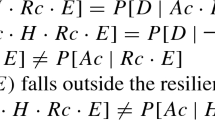Abstract
In this commentary I respond to Lewis (2019) and Lanier (2019), building on their critiques and ideas, offering some additional thoughts about the dissemination of the Campbell, Rubin, and Pearl causal frameworks and their potential emergent value to the future of family violence research. I clarify that the central issue to credibility is the plausibility of assumptions, that some widely utilized methods often require researchers to make implausible assumptions, and that there is value to knowing and using all three frameworks.
Similar content being viewed by others
References
Angrist, J. D., & Pischke, J. S. (2009). Mostly harmless econometrics: An empiricist’s companion. Princeton, NJ: Princeton University Press.
Austin, A. E., Desrosiers, T. A., & Shanahan, M. E. (2019). Directed acyclic graphs: An under-utilized tool for child maltreatment research. Child Abuse & Neglect, 91, 78–87.
Barnighausen, T., Oldenburg, C., Tugwell, P., Bommer, C., Ebert, C., Barreto, M., et al. (2017). Quasi-experimental design series—Paper 7: Assessing the assumptions. Journal of Clinical Epidemiology, 89, 53–66.
Guo, S., & Fraser, M. W. (2015). Propensity score analysis: Statistical methods and applications (2nd ed.). Thousand Oaks, CA: Sage Publications.
How to solve U.S. social problems when most rigorous program evaluations find disappointing effects (part two – A proposed solution). (April 13, 2018). Retrieved from: https://www.straighttalkonevidence.org/2018/04/13/how-to-solve-u-s-social-problems-when-most-rigorous-program-evaluations-find-disappointing-effects-part-two-a-proposed-solution/.
Lanier, P. (2019). Frameworks of causal inference for improving intervention, prediction, and imagination in family violence research: A commentary on Rose (2019). Journal of Family Violence.
Lewis, M. E. (2019). TITLE: A commentary on Rose (2019). Journal of Family Violence.
Morgan, S. L. & Winship, C. (2014). Counterfactuals and causal inference: Methods and principles for social research (2nd ed.). New York: Cambridge University Press.
Pearl, J. (2009). Causality: Models, reasoning, and inference (2nd ed.). Cambridge, UK: Cambridge University Press.
Pearl, J., & MacKenzie, D. (2018). The book of why: The new science of cause and effect. NY: Basic Books.
Rose, R. A. (2019). Frameworks for credible causal inference in observational studies of family violence. Journal of Family Violence.
Shadish, W. R. (2010). Campbell and Rubin: A primer and comparison of their approaches to causal inference in field settings. Psychological Methods, 15(1), 3–17.
Shadish, W. R., Clark, M. H., & Steiner, P. M. (2008). Can nonrandomized experiments yield accurate answers? A randomized experiment comparing random and nonrandom assign- ments. Journal of the American Statistical Association, 103(484), 1353–1356. https://doi.org/10.1198/016214508000000733.
Stone, S. (2014). Comtemporary quantitative methods and “slow” causal inference: Response to Palinkas. Research on Social Work Practice, 24(5), 552–555.
Thoemmes, F. F. J., & Kim, E. S. (2011). A systematic review of propensity score methods in the social sciences. Multivariate Behavioral Research, 46(1), 90–118.
Vanderweele, T. (2015). Explanation in causal inference. NY: Oxford University Press.
Acknowledgments
The author appreciates the commentary provided by Dr. Paul Lanier, Dr. Michael Lewis, and an anonymous third review to the original article and the helpful comments of Rebecca J. Macy to an earlier draft of this response.
Author information
Authors and Affiliations
Corresponding author
Additional information
Publisher’s Note
Springer Nature remains neutral with regard to jurisdictional claims in published maps and institutional affiliations.
Rights and permissions
About this article
Cite this article
Rose, R.A. No Credibility without Plausibility: a Response to Lewis and Lanier. J Fam Viol 34, 719–722 (2019). https://doi.org/10.1007/s10896-019-00080-0
Published:
Issue Date:
DOI: https://doi.org/10.1007/s10896-019-00080-0



